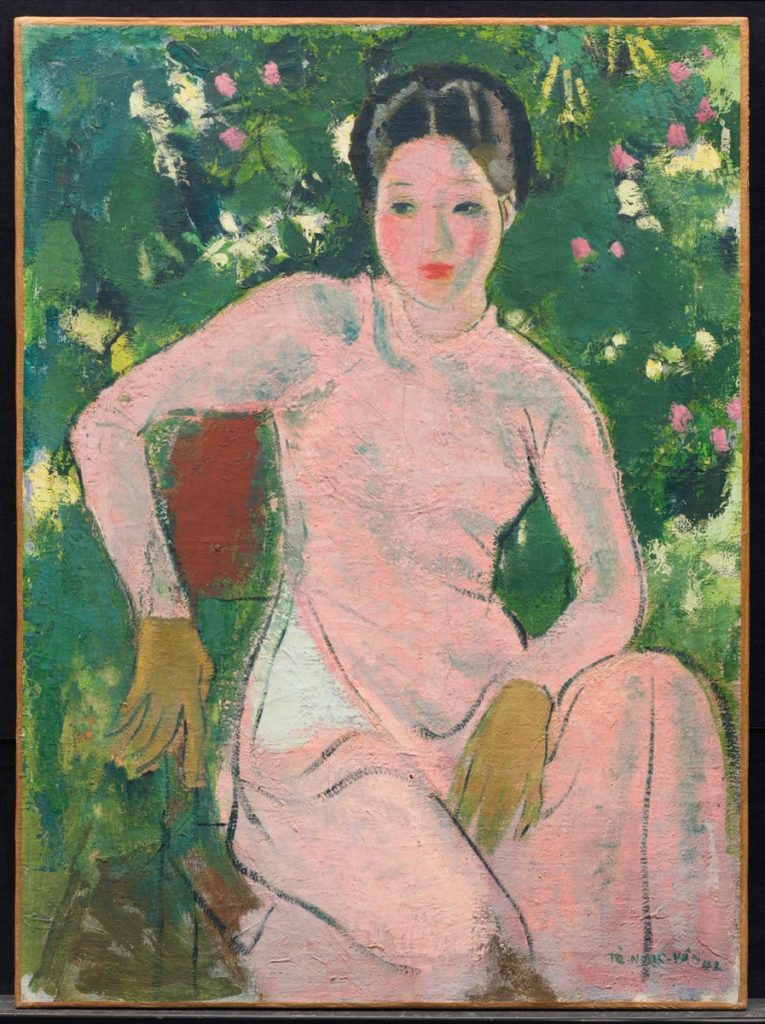To Ngoc Van, 1942 « The Young Woman » or the certainty of truth
When To Ngoc Van painted this picture, he was 36 years old and had an accomplished social life: a graduate of the Hanoi School of Fine Arts, his native city, in 1931, a multi-prize-winning artist, a former Director of the Phnom Penh School of Fine Arts (1935-38) and then a professor at the Hanoi School of Fine Arts of Hanoi.

That same year, 1942, he created the FARTA (Foyer de l’Art Annamite) with Lé Van Dé, Tran Van Can, Luong Xuan Nhi, Nguyen Khang and Georges Khanh. An autonomous place where artists could exhibit their works and confront their ideas. This approach took up the ideology of the nationalist literary group founded in 1932, the Tu Luc Van Doan.To Ngoc Van was not one of the seven founding members (Nguyen Gia Tri was), but he actively participated in the periodicals Phong Hoà (Morals) and Ngay Nay (Today), both of which supported the group. To advocate the modernization of Vietnamese society, culture and literature, such was the ambition of the movement. This implies “Recognizing the role of women in society” as stated in point 6 of the “Ten precepts to ponder” of a movement that also fought against a Confucianism that it considered obsolete.
The appropriation of Western concepts should allow for the regeneration of the Vietnamese nation and then later for its independence.
Our oil on canvas (73 x 54 cm) testifies to this homage-promotion To Ngoc Van makes to Vietnamese woman: her modern ao dai, her tonkinese hairstyle, her make-up, her swaying pose, the hands just sketched are already pictorial classics in 1942. Her posture, defying the Confucian submission and the requirement that one reads in her look are innovative. The vegetal and floral background dominated by a deep green dotted with pink, yellow and white touches vivifies the beautiful Hanoian.
Five years later, To Ngoc Van, the patriot, left Hanoi for the Viet Bac maquis. There, he exercised multiple responsibilities in the fight for independence. But the patriot did not erase the artist: in an article dated July 1, 1947, he opposed art and propaganda and (re)affirmed that the first had an eternal value, the second a momentary interest. In 1949, in another article (“Should we or should we not study?”) he will deny to the masses the faculty to criticize the artists because they do not have the necessary qualification, for lack of study(s)… Nguyen Dinh Thi (1924-2003) will counter him in a great debate (September 25-28, 1949) in the Viet Bac.
End of ban…
Later, in 1953, To Ngoc Van was sent for re-education in the village of Ninh Dhan near Phu To.
To Ngoc Van produced few works (except for numerous drawings) and this one is exceptional. Bought directly from the artist by Léon Lipschutz, attorney of the Banque Franco-Chinoise in Hanoi, our painting was brought back to France in 1946. It kept its original 1940’s frame .
An exceptional artist, skilled in all techniques as evidenced by “Les désabusées” (on silk) from the Tuan Pham collection, To Ngoc Van was a great humanist, one of those who seek the certainty of truth, against the violence of thought.
Jean-François Hubert